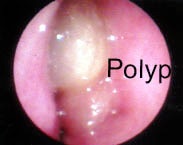Nasal polyps

IMPORTANT The information provided is of a general nature and should not be used as a substitute for professional advice. If you think you may suffer from an allergic or other disease that requires attention, you should discuss it with your family doctor. The content of the information articles and all illustrations on this website remains the intellectual property of Dr Raymond Mullins and cannot be reproduced without written permission.
Summary
Nasal polyps are soft, jelly-like overgrowths of the lining of the sinuses. They look like grapes on the end of a stalk. Large polyps can bloc the nose and increase the risk of sinusitis.
What are nasal polyps?
Nasal polyps occur in around 1 in 200 people. Polyps are soft, jelly-like overgrowths of the lining of the sinuses. They look like grapes on the end of a stalk. The result is often a blocked nose. They usually only cause symptoms when they grow through the tunnel that connect the sinuses to the nose. Large polyps can bloc the nose. More importantly, they can block the tunnels connecting the nose to the sinus cavities. Like water in a stagnant pond, and increase the risk of sinus infection (sinusitis). They are rarely cancerous.
What is the cause?
The cause is unknown, but inflammation in the sinuses (from allergy or infection) may trigger polyps and make them grow faster, and make them come back faster after sinus operations. Sometimes other conditions may occur with greater frequency in people with nasal polyps. These include sinus infections, asthma and allergy to aspirin. While they have so-called “allergy white cells” known as eosinophils, and while some pathologist report them as “allergic polyps”, in fact allergy is no more common in people with polyps than the general population.
Options for treatment include:
1. Surgical removal, although they will regrow eventually in around 50% of people.
2. Cortisone tablets will shrink them down temporarily, and can't be taken long-term because of side-effects.
3. Cortisone / steroid nose sprays (eg Avamys, Rhinocort, Nasonex) slow polyp growth. Patients with recurrent polyps who have had multiple operations are often advised to stay on these sprays forever. In patients with recurrent disease, nasal steroid sprays should be considered as "weed killers", which need to be used continuously. Slower growth means fewer sinus infections, less antibiotics and less frequent surgery.
4. Allergy desensitisation injections are sometimes used in allergic patients with hay fever as well as polyps. While this often helps hay fever, there is no convincing evidence that this treatment makes polyps grow slower.
-
5.Diet. There is no evidence that altering diet will help.
-
6.Other. There is some evidence that montelukast tablets can shrink polyps and there are also reports and small series using a nasal spray containing a diuretic (frusemide) can shrink polyps as well.
Patients with aspirin allergy have more options
Some patients suffer from aspirin allergy, nasal polyps and asthma, a condition known as the aspirin triad. This can develop later in life. Even though these patients are allergic to aspirin, most can be made to tolerate high doses by starting off at a very low dose of aspirin initially (and increasing it day by day. Once a higher dose is reached, aspirin desensitisation can reduce asthma severity, the rate of polyp regrowth, and the severity of sinusitis. The decision to undertake aspirin desensitisation is best made by an allergy specialist. Sometimes, you may need to do a deliberate aspirin challenge to find out whether or not you are allergic to aspirin.
References
Djukanovic R. Nasal polyps-a model of chronic respiratory mucosal inflammation. Clin Exp Allergy 1995; 25: 582-85.
Granstrom G et al. Influence of allergy, astham and hypertension on nasal polyposis. Acta Otolaryngol (Stockh) 1992; Suppl 492: 22-7.
Spector SL. Overview of comorbid associations of allergic rhinitis. J Allergy Clin Immunol 1997; 99: S773-80.
Slavin RG. Nasal polyps and sinusitis. JAMA 1997; 278: 1849-54.
Steiner PL. Nasal polyps: relationship to infection and inflammation. Allergy and Asthma Proceedings 1996; 17: 251-7.
Settipane GA. Epidemiology of nasal polyps. Allergy and Asthma Proceedings 1996; 17: 231-6.
Last reviewed 29 May 2020
